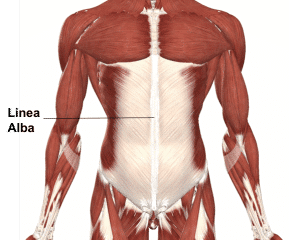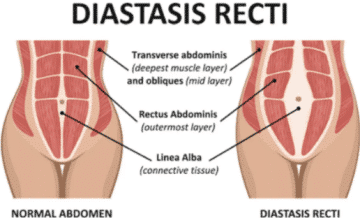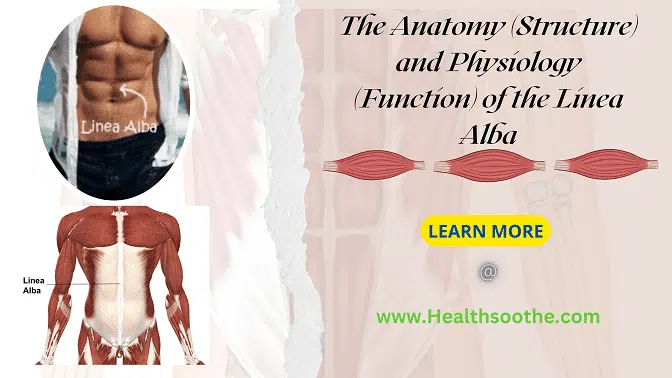Overview and Introduction of the Linea Alba
[ninja_tables id=”73298″]

The linea alba is a strip of tissue (connective) that extends from the sternum to the public bone of a person.[mfn]The free dictionary Linea Alba Available: https://medical-dictionary.thefreedictionary.com/linea+alba (accessed 07.11.2022)[/mfn] It aids in the stabilization and bracing of the core muscles. Overstretching might cause it to become damaged and feeble. Exercises & physical therapy are used by healthcare practitioners to address linea alba issues.
It divides your rectus abdominis into left and right sides. The rectus abdominis is also known as the “six-pack abs” since it runs from the lower end of the sternum (breastbone) to the public bone.
In Latin, linea alba signifies “white line.” In those with muscular abdominals, the linea alba shows as a colorless groove (forming the popular ‘six-pack’). It blackens and becomes the linea nigra during pregnancy[mfn]ken Hub Linea Alba Available: https://www.kenhub.com/en/library/anatomy/linea-alba (accessed 07.11.2022)[/mfn].
Pregnancy and obesity may both induce weakening in the linea alba. For example, it splits when your uterus develops and the stomach wall is pushed outward. As a consequence, it reduces in flexibility and becomes weaker. Diastasis recti is a disorder in which the abdominal muscles stay divided, causing a protrusion in the abdomen.
The Structure and Function of the Linea Alba
The linea alba is sturdy and incredibly elastic.[mfn]Radiopaedia. Linea alba. (https://radiopaedia.org/articles/linea-alba?lang=us) Accessed 7/11/2022.[/mfn] It serves as an attachment site for other stomach muscles and aids in the anchoring and stabilization of your torso. If it is weak, people might have pelvic/back discomfort, bad posture, and other issues.
At its broadest point, it may be around 2.25cm wide[mfn]Beer GM, Schuster A, Seifert B, et al. The normal width of the linea alba in nulliparous women. (https://pubmed.ncbi.nlm.nih.gov/19637295/) Clin Anat. 2009 Sep;22(6):706-11. doi: 10.1002/ca.20836. PMID: 19637295. Accessed 7/11/2022.[/mfn] (usually above the navel). It extends first from the top of the abdomen (just beneath the sternum) towards the public bone. The linea alba might extend as a result of pregnancy or severe abdominal strain. As a result, the linea alba may be wider than 2.25 cm.
Its principal role is to keep the left and right abdominal muscles apart. The linea alba is also connected to the transverse abdominis and obliques (your other abdominal muscles), helping it act as an anchor in your torso.
It also aids in the absorption of force or pressure on your abdomen, and is very elastic and expandable. It must, however, have the ability to stiffen or constrict in order to hold your abdominals and stabilize your motions.
To know more on the linea alba, watch the video below:
The Development of the Linea Alba
The linea alba is formed by the interlacing aponeuroses of three vertical abdominal muscles: external oblique, internal oblique, and transversus abdominis muscles.
Does the Linea Alba Have a Blood Supply and Lymphatics?
Linea alba is devoid of blood supply & innervation in general, however, a few minor blood vessels pass to the other side over its front surface. As a result, it is often used as a puncture site and incision area in suprapubic bladder catheterization and abdominal surgery, respectively.
What are the Nerves of the Linea Alba? – Does the Linea Alba Have any Nerves?
The linea generally lacks innervation, and that is why it has nerves.
What are the Muscles of the Linea Alba?

The Linea Alba is a connective tissue that doesn’t have any muscles, but rather it serves as a point of connection for other muscles (external oblique, internal oblique, and transversus abdominis muscles).
Internal oblique, external oblique, and transversus abdominis aponeuroses run vertically over the anterior region of the abdomen. As they pass to the other side, their fibers (aponeurotic) intertwine along the centerline of the abdomen, developing the linea alba just at the decussation. This interlacing occurs between matching layers of related muscles (e.g., superficial-to-superficial, deep-to-deep) as well as between separate muscles (external oblique-internal oblique). Furthermore, the several layers (aponeurotic) (deep, intermediate, and superficial) are intertwined between them.
Exercises and the Linea Alba? – Does Exercise Help Improve Your Linea Alba?
Yes, you may develop this muscle with workouts. There are certain workouts you can take to help reduce the space between the rectus abdominis if you have diastasis recti or ab separation. You may improve it by doing the following:
- Avoid straining while lifting.
- Avoid sit-ups and other abdominal-pressure exercises.
- Maintain proper posture.
- Deep breaths that enable the ribcage to extend are recommended.
Before commencing any workouts to enhance it, consult with your healthcare physician. Exercising inappropriately might result in more separation and a weaker linea alba.
The Clinical Significance of the Linea Alba
The linea alba may cause a paraumbilical hernia. They are often associated with diastasis recti.
The linea alba is attached to the transverse abdominal muscle. During pregnancy, it loses strength. Exercising (strengthening) the transverse abdominal muscle after baby delivery may be an effective strategy to repair the muscle’s integrity.
Because the muscle is primarily connective tissue and lacks principal nerves and blood arteries, a median incision across it is a typical surgical method (laparotomy incision).
As the baby and belly develop and stretch during pregnancy, it darkens and is referred as the linea nigra (Latin for “black line”), which is really browner in hue. The linea nigra normally extends first from pubic bone to the belly button or higher.
It sometimes progresses to the ribcage. Because of the elevated amounts of estrogen during pregnancy, the body creates additional melanin, which is accountable for the development of linea nigra. The linea alba can heal on its own. If it separates during pregnancy, it will start to close on its own as your muscles regain strength.
Conditions Associated with the Linea Alba

The linea alba has the ability to stretch just like a rubber band. When a woman is pregnant or obese, it extends to accommodate her expanding belly. Sometimes even it is extended so far that it fails to rejoin.
As a consequence, the abdominals stay split on the right and left sides. This is referred to as an abdominal separation or ab gap. physical therapy or exercises may usually aid in the healing of an ab gap.
Some abdominal separation is normal, particularly during pregnancy. Diastasis recti is defined as an abnormal separation of the abdominal muscles. It might result in a noticeable bulge or pooch around your belly.
Symptoms of an overstretched or weak linea alba include:
- When you tense your ab muscles, you are coning or doming.
- Difficulties in lifting items, walking, or performing daily duties.
- Hip or pelvic discomfort
- Pain in the lower back.
- Bad posture.
- Urine leakage.
A hernia in this muscle occurs in certain patients. This causes it to swell. When this muscle is weak, this might happen.
The Summary on the Linea Alba
| Origin | Tip of xiphoid process |
| Insertion | Anterior fibres: pubic symphysis Posterior fibres: pubic crests on both sides |
| Structure | Formed by aponeuroses of external oblique, internal oblique and transversus abdominis |
| Function | Attachment site for: – Fundiform ligament of penis – Pyramidalis, internal oblique, external oblique and transversus abdominis muscles – Parietal peritoneum via extraperitoneal connective tissue |
Everyone has an alba linea. It functions as an anchorage for your abdominals and helps to stabilize your core. It may be injured by being overstretched during pregnancy.
A deficient linea alba can cause back discomfort, gastrointestinal problems, or make you feel agitated. Consult your doctor if you believe it is compromised or producing complications.
Muscular strength exercises and physical therapy may typically aid in the healing of a linea alba that is damaged as well as disorders such as diastasis recti.
All right, guys, that is it for now for the linea alba. I hope Healthsoothe answered any questions you had concerning it.
Feel free to contact us at contact@healthsoothe.com if you have further questions to ask or if there’s anything you want to contribute or correct to this article. And don’t worry, Healthsoothe doesn’t bite.
You can always check our FAQs section below to know more about the linea alba. And always remember that Healthsoothe is one of the best health sites out there that genuinely cares for you. So, anytime, you need trustworthy answers to any of your health-related questions, come straight to us, and we will solve your problem(s) for you.
[bwla_faq faq_topics=”frequently-asked-questions-about-the-linea-alba” sbox=”1″ paginate=”1″ pag_limit=”5″ list=”1″ /]





